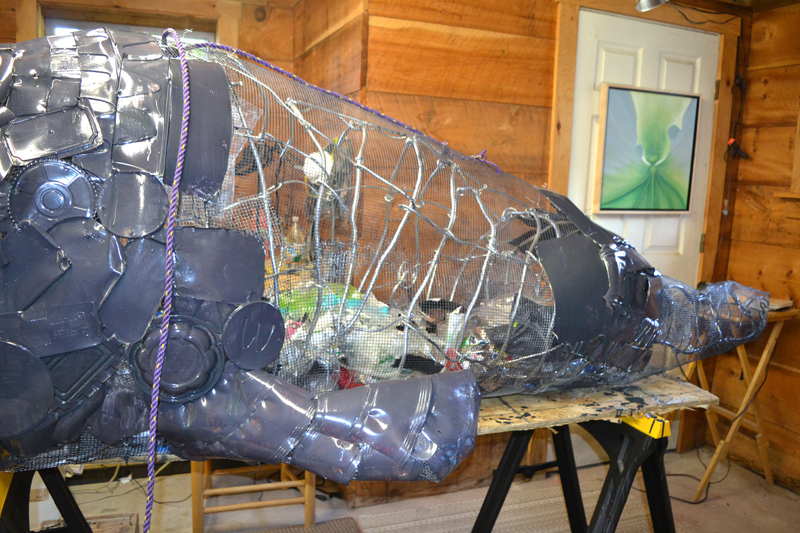
Artist Marnie Sinclair works on her seal sculpture titled “Seamore Plastic” at River Arts in Damariscotta on Wednesday, Oct. 9. (Christine LaPado-Breglia photo)
Wanting to see less plastic: I like hanging out with Damariscotta artist Marnie Sinclair. Every so often, the enthusiastic Sinclair just pops up on my arts radar and we chit-chat about her latest project – always, it seems, focused on the environment.
On Wednesday, Oct. 9, I visited Sinclair, who, in addition to being a painter and a pastel, sculpture, and video artist, is the author of the attractive, stimulating, and photo-heavy book “Balance & Imbalance: A Celebration of Nature and a Call to Action.” The book focuses on climate change, environmental degradation, and nature’s adaptations to such challenges. Sinclair had called me to tell me about the giant seal sculpture she was making out of recycled plastic, wire, and heavy-duty hardware cloth.
Giant seal sculpture? Of course, I had to go check it out.
There was Sinclair, down in the basement-slash-workshop area of River Arts in Damariscotta, where another artist was also busy at work on a project. And there was the giant seal, who measures a whopping 8 feet, 4 inches long, by 3 feet high, by 4 feet, 2 inches wide. Sinclair has been busy working on the seal, incorporating nonrecyclable plastic food containers painted dark gray, for the last couple of months.

“Seamore Plastic” from the neck down. The entire body of Marnie Sinclair’s seal sculpture measures 8 feet, 4 inches long by 3 feet high and 4 feet, 2 inches wide. Here, the viewer gets a look at the plastic garbage inside his stomach, a comment by the artist on the amount of plastic that ends up in the oceans. (Christine LaPado-Breglia photo)
The seal’s name, fittingly, is “Seamore Plastic.”
Seamore the seal is the last piece Sinclair is making for her upcoming art exhibit focused on environmental problems (such as too much plastic garbage), running Monday, Oct. 28 through Nov. 18 , in the lobby of the Leadership in Energy and Environmental Design-certified Diamond Building at Colby College in Waterville. The show’s opening reception will take place from 4-6:30 p.m. on Nov. 1 and Sinclair will give a talk on the exhibit on Nov. 15 in that same building immediately following an 11:30 a.m. luncheon.

Mother Petro, toddler Ollie, and baby Um make up this recycled plastic sculpture by Marnie Sinclair focused on the word “petroleum.” The sculpture, along with “Seamore Plastic,” a seal made of recycled plastic, and approximately 40 other pieces, will be part of Sinclair’s upcomng show opening Nov. 1 at Colby College in Waterville. (Photo courtesy Marnie Sinclar)
The plastic Sinclair used to make Seamore – familiar items like McDonald’s salad containers and Dunkin’ cup lids – are “all pieces of plastic that cannot be recycled in the Damariscotta dump,” Sinclair noted.
Sinclair is clearly dismayed by the rampant production and use of plastic, especially the nonrecyclable kind, a situation that came about since China stopped accepting many types of previously recyclable plastics. Local food-selling businesses, Sinclair is quick to remind us, are “full of plastic. Every time you go to buy a salad, it’s in plastic. It’s just not right.”
Getting rid of plastic grocery bags is just a beginning, she offers. “(Grocery stores) still have the plastic bags for vegetables, and all those (plastic) containers!”
Sinclair said that when she gives her talk at Colby, she will suggest that “they could have a little competition and they could make sea mammals with the same materials (nonrecyclable plastics) and fill them with plastic – whatever can’t be used as plastic ‘skin’ can go inside as plastic detritus,” like Sinclair did with Seamore, whose see-through abdomen is loaded with plastic garbage.
“They could put (the sculptures) around the campus to raise awareness,” she said.
“I don’t want it to be too depressing,” said Sinclair of her Colby show, which will feature educational statements next to each piece, “but, on the other hand, I want to make a point. … It’s a reminder that we’ve got trash everywhere – the same as all the plastic in (Seamore’s) stomach.”
Sinclair takes a breath and adds, only half-jokingly, “If I had time, I’d make a cockroach, because I think that’s the only one that’s going to survive.”
For more information on Sinclair’s art and book (including a video about her “Balance & Imbalance” project), go to bristolroadgalleries.com/theartists.html. Learn even more at marniesinclair.net.
(Christine LaPado-Breglia has written about the arts in both California and Maine. She is the recipient of two 2018 Critic’s Awards and a 2018 Local Columnist award from the Maine Press Association. Email her at clbreglia@lcnme.com or write her a letter in care of The Lincoln County News, P.O. Box 36, Damariscotta, ME 04543.)



